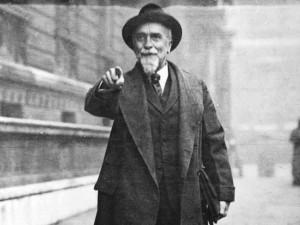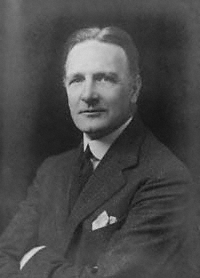by Pete Goddard and Atul Hatwal
By 1931, prime minister Ramsay Macdonald had made his choice: he was going to cut his way out of Britain’s financial crisis. Austerity beckoned.
But first, as ever, a committee.
The national expenditure committee was set up on February and was due to report in July. So obviously it became known as the May committee. Admittedly this was because the committee chair was Sir George May, recently retired as company secretary at the Prudential, but did they have to make things so confusing?
Oswald Mosley, who had been unsuccessfully touting his alternative, spending-based recovery plan around the party, couldn’t take it anymore. In February 1931, he voted with his feet, resigning from the Labour party completely.
Mosley then gathered a handful of his closest MP friends to form a new party. He showed that his new party had the imagination and vision that Labour lacked, by calling it the New party.
The New party betrayed a few hints of what was to come for Mosley by forming its very own militia. This might have been frightening had it not been for their choice of nickname: the “Biff Boys” sounded less a jackbooted menace and more a carefree gay subculture.
Meanwhile, back in the Labour party, Mosley and friends weren’t the only ones losing faith. In March 1931, the former Liberal Charles Trevelyan resigned as minister for education after his efforts to raise the school leaving age to 15 hit the rocks.
The PLP responded characteristically to the growing signs of crisis, by clinging to their leaders ever more tightly.
When Trevelyan gave a speech at a party meeting explaining his resignation and excoriating Ramsay Macdonald, the rest of the PLP was at the back of the room fighting over the chocolate Hob Nobs and trying not to listen. The grand old man of the PLP Will Thorne, founder of the gasworkers’ union, declared Trevelyan’s resignation to be “particularly mean.”
These were mean times though.
In July 1931, minister for labour Margaret Bondfield put through the anomalies act, intended to save money on the nation’s unemployment benefit bill. It did this by eradicating anomalies in the system such as, er, allowing married women to claim unemployment benefit. Because looking after your husband is a full time job in itself, am I right guys? Guys?
Then, on the 31st July came the big one: the national expenditure committee report.
Sir George May’s team had calculated a deficit for the following year of an unprecedented, £120 million which in today’s money is just under £7bn, or ¾ of an Olympics.
Back then, the consensus was that this level of debt was a total catastrophe.
To tackle it, the May committee suggested cuts, cuts and more cuts. A total of £96 million in reductions were proposed. This included 20% off unemployment benefit and 20% off some public servant salaries including teachers and police but not, funnily enough, MPs.
The cuts were shocking to many, but not to Philip Snowden, who was already sharpening his economic scythe. In fact, rumour had it that the dry-as-dust orthodox chancellor had actually encouraged a frightening report, hoping to scare everyone else into supporting the cuts he believed were needed to balance his budget.
Unfortunately, when generating bad news for his Labour audience, Snowden seems to have forgotten that foreigners can read too. Specifically, foreign investors.
The May report spooked markets that were already jittery following the collapse of Austria’s Kreditanstalt bank and the recent departures of Austria and Germany from the gold standard.
Believing the British economy to be in trouble, investors started to withdraw vast sums of money from sterling and putting their Royal Mint commemorative collections on eBay.

Montagu Norman, Governor of the Bank of England “My country needs you… to lend us about 80 million quid please.”
In itself this needn’t have been a problem if the currency had been allowed to depreciate. The pound would have fallen sharply and then, as British exports became cheaper and sales increased, its value would have risen to a new stable rate. All just as every GCSE economics student is taught.
Unfortunately for Britain, GCSEs didn’t exist in 1931 [insert your own Michael Gove joke here]. The idea of devaluation was political heresy, being synonymous with the rampant inflation of 1920s Germany and Bad Things happening.
Unwilling to risk Labour’s economic credibility, the unanimous position in the cabinet was to remain on the gold standard. After all, you wouldn’t call it a gold standard if it wasn’t a good thing, would you?
With that decision, Britain’s deficit drama became a foreign exchange crisis.
The money continued to flood out of sterling and every day Britain needed to borrow millions more to prop the currency up.
Britain’s credit couldn’t last forever though.
Something had to give.
Pete and Atul are not historians
Tags: Atul Hatwal, gold standard, Labour history uncut, May committee report, Pete Goddard, Ramsay Macdonald, Sir George May











Atul +Goddard deserve their own Fringe Meeting at Brigton this Sept.
Their understanding of the situation is spot on, even for novices.
Another enthralling episode leaving you wondering how it will all turn out in the end.